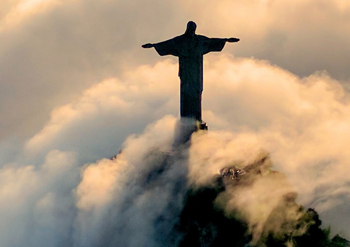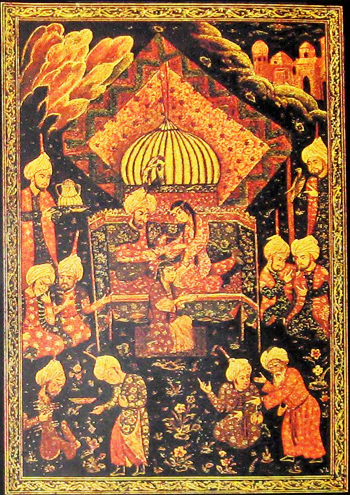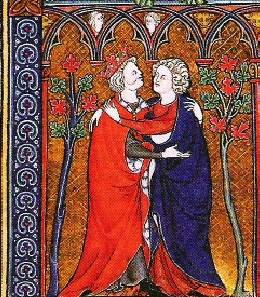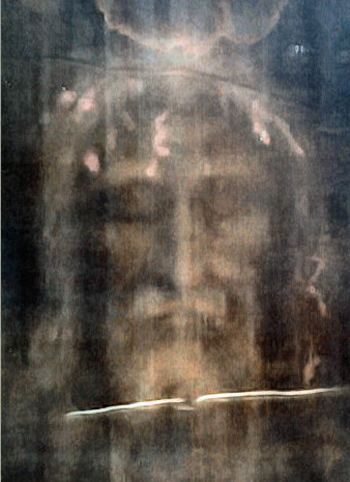Catholic Virtues
 |
 |
 |
 |
 |
 |
 |
True & False Paths to Happiness - XXIV
The ‘Fourth Way’ of St. Thomas that
Wakens the Thirst for God in Men
In the last article, I showed how important it is to awaken in the soul the "roar" of the absolute. Even more, it is a primary duty to try to preserve and intensify this "roar."
 "Roaring" is an energetic word. But if, as has been previously noted, just as those who thirst yearn for water so also does what is contingent naturally seek the absolute. This emphasis thus seems appropriate. It can even be said that what is most noble is man is the "roar" of the absolutes.
"Roaring" is an energetic word. But if, as has been previously noted, just as those who thirst yearn for water so also does what is contingent naturally seek the absolute. This emphasis thus seems appropriate. It can even be said that what is most noble is man is the "roar" of the absolutes.
One of the great mistakes of modernity is to create the illusion that material goods are the final end of life. An antidote to this defect would be to develop the symbols of the absolute with a view toward making a new, splendid, magnificent and entirely Christian Civilization.
It is towards this goal that all the thoughts of our mind, all the yearnings of our heart and all the efforts of our being must be directed.
Awakening the thirst for God in contemporary men
In our times this question arises: In view of today's insoluble problems and the ineffectiveness of all the proposed solutions, would there be a solution in a greater and more profound sphere?
 Given the unfeasibility of the suggested solutions, it is fitting to propose awakening the thirst for God in one of the most suitable ways to attract contemporary man: the so-called “fourth way” of St. Thomas Aquinas, (1) which stands out among the five fundamental proofs he developed for the existence of God – which, by the way, he does pretend are the only ones.
Given the unfeasibility of the suggested solutions, it is fitting to propose awakening the thirst for God in one of the most suitable ways to attract contemporary man: the so-called “fourth way” of St. Thomas Aquinas, (1) which stands out among the five fundamental proofs he developed for the existence of God – which, by the way, he does pretend are the only ones.
The “fourth way” of St. Thomas, in turn, has a connection with the theory of “participation,” which is pointed out by excellent authors based on the metaphysics of the Angelic Doctor. The search for the absolute – which was discussed in previous articles – is closely connected to these two themes.
The ‘fourth way’: to aspire to something far superior to nature
How can one make a sacred contemplation of the universe following the method of the “fourth way” of St. Thomas Aquinas? (2)
As beautiful as nature is – and it is extraordinarily so – it satisfies neither the desire for beauty nor the desire for well-being in man. In man, an exiled from the earthly Paradise, there is something that is always seeking beauty, amenities and higher delights. He aspires to something more marvelous, something far superior to his own nature. The earthly Paradise would have been in some way what he looks for.
 The tales of The Thousand and One Nights and fairy tales are literary artifices for man to sense something of the magnificence of this nature for which he was created and does not find on this Earth. When man looks up at the stars, he naturally has the desire to fly, the will to enter those altitudes.
The tales of The Thousand and One Nights and fairy tales are literary artifices for man to sense something of the magnificence of this nature for which he was created and does not find on this Earth. When man looks up at the stars, he naturally has the desire to fly, the will to enter those altitudes.
In the liturgy there are phrases like this: "I dwell in the highest Heavens, my throne is on a pillar of clouds." (3) It is an inspired phrase, which corresponds to the desire of the human creature to install a throne atop the clouds and gaze at the Earth below him. This aspiration elevates us to the "fourth way." Discerning the spiritual in concrete things.
The body is in some way the symbol of the soul, and the properties of the soul radiate in it. When a person possesses certain attributes in a very high degree, it is possible to see his soul in his physical body, that is, a reality that is above the physical reality.
This is the first step in applying the “fourth way”: To perceive something in a physical thing that is not sensitive, but spiritual. It is not a physical thing; therefore; the eyes neither see it nor the senses feel it, but it nonetheless appears in physical things.
The most perfect example – adorable in every sense of the word – is the Face of Our Lord Jesus Christ on the Shroud of Turin. There one perceives the soul, the sanctity, of Our Lord Jesus Christ, symbolized in His Face. Something of His very soul – therefore a spiritual reality – is symbolized there.
What is participation?
Describing the "fourth way" of St. Thomas is an invitation to speak about participatio (participation). This is the property that one thing has to receive the properties of another; for this reason, the one becomes in a certain way a part of the nature of the other.
Infinitely below God are the Angels. The angel per se is not purity, but there is a special Angel of Purity, which is the standard of purity for all of Creation. This Angel has a very great participation in the purity of God. This Angel is a kind of fountain of purity that participates, in varying degrees, in everything that has purity. Everything that is pure has a participation in the purity of the Angels.
 The same is true of all perfections.
The same is true of all perfections.
Sacred Scripture describes a type of of participation existing between David and Jonathan, who became like two brothers united in friendship and a profound mutual understanding in such a way that each loved the other as he loved himself (sicut animam suam, ita diligebat eum - 1 Sam 20:17).
It should be noted that in such participation, there is still alterity, the sense of one's own being as separate from the other. Participation is a kind of bridge between two alterities. There is, however, something ontological when a participation exists. It is not a perfect resemblance.
It is necessary to see in the participation something more than a similarity, but something that does not harm the otherness of the two beings. Incommunicability is the real foothold of participation: that is, participation represents the highest communication between two beings, but it has a limit: the alterity between the two is conserved.
Participation has two faces, because it is a communication, but it only makes sense departing from and in function of individuality. Participation and communication constitute, between themselves, a kind of harmonic binomial.
Everything that exists has certain attributes that participate in the attributes of another being which has them in a greater degree. It is not just people who have attributes, but also irrational beings and even inanimate beings.
Therefore, whenever an attribute exists in a certain being, that attribute participates in an attribute of another higher being.
 Let us take, for example, the color red. There is the whole range of reds, but there must be, somewhere in Creation, a perfect and ideal red; the absolute, archetypal red, which is the perfection of red, and in which all other reds participate. This red is the monarch of the reds.
Let us take, for example, the color red. There is the whole range of reds, but there must be, somewhere in Creation, a perfect and ideal red; the absolute, archetypal red, which is the perfection of red, and in which all other reds participate. This red is the monarch of the reds.
What sustains this red in its color is the fact that, in the order created by God, a greater red exists, a red in which all the others participate. If it did not exist, the existence of lesser reds became problematic.
The same can also be said of human qualities. Throughout history, mankind has generated perfect human types, above all with the assistance of the Church, who checks the effects of original sin and brings men who correspond to grace to the highest sanctity.
Lesser perfections, which are born from the inspiration of a greater one, are supported by the latter. Thus, all Creation must be seen as a series of types that are staggered in relation to one another and whose apex is an archetype. This archetype, in turn, has its highest realization in an Angel. The Angels are purely spiritual archetypes of the qualities that exist in Creation. (4)
Some Angels, in turn, are archetypes of others and, in this way, God is reached, who is the foundation of this whole hierarchy of analogies and participations because He is perfect, supreme and uncreated. It is not correct to say that God "has" qualities: He is the qualities that he has. And all the qualities that exist on Earth are participations of His qualities.
 Continued
Continued


An efficient modern neighborhood that satisfies the body but not the soul
One of the great mistakes of modernity is to create the illusion that material goods are the final end of life. An antidote to this defect would be to develop the symbols of the absolute with a view toward making a new, splendid, magnificent and entirely Christian Civilization.
It is towards this goal that all the thoughts of our mind, all the yearnings of our heart and all the efforts of our being must be directed.
Awakening the thirst for God in contemporary men
In our times this question arises: In view of today's insoluble problems and the ineffectiveness of all the proposed solutions, would there be a solution in a greater and more profound sphere?

The Christ the Redeemer atop a mountain in Rio transmits something beyond the natural
The “fourth way” of St. Thomas, in turn, has a connection with the theory of “participation,” which is pointed out by excellent authors based on the metaphysics of the Angelic Doctor. The search for the absolute – which was discussed in previous articles – is closely connected to these two themes.
The ‘fourth way’: to aspire to something far superior to nature
How can one make a sacred contemplation of the universe following the method of the “fourth way” of St. Thomas Aquinas? (2)
As beautiful as nature is – and it is extraordinarily so – it satisfies neither the desire for beauty nor the desire for well-being in man. In man, an exiled from the earthly Paradise, there is something that is always seeking beauty, amenities and higher delights. He aspires to something more marvelous, something far superior to his own nature. The earthly Paradise would have been in some way what he looks for.

The Arabian Nights tales: A means to find a marvelous beyond nature
In the liturgy there are phrases like this: "I dwell in the highest Heavens, my throne is on a pillar of clouds." (3) It is an inspired phrase, which corresponds to the desire of the human creature to install a throne atop the clouds and gaze at the Earth below him. This aspiration elevates us to the "fourth way." Discerning the spiritual in concrete things.
The body is in some way the symbol of the soul, and the properties of the soul radiate in it. When a person possesses certain attributes in a very high degree, it is possible to see his soul in his physical body, that is, a reality that is above the physical reality.
This is the first step in applying the “fourth way”: To perceive something in a physical thing that is not sensitive, but spiritual. It is not a physical thing; therefore; the eyes neither see it nor the senses feel it, but it nonetheless appears in physical things.
The most perfect example – adorable in every sense of the word – is the Face of Our Lord Jesus Christ on the Shroud of Turin. There one perceives the soul, the sanctity, of Our Lord Jesus Christ, symbolized in His Face. Something of His very soul – therefore a spiritual reality – is symbolized there.
What is participation?
Describing the "fourth way" of St. Thomas is an invitation to speak about participatio (participation). This is the property that one thing has to receive the properties of another; for this reason, the one becomes in a certain way a part of the nature of the other.
Infinitely below God are the Angels. The angel per se is not purity, but there is a special Angel of Purity, which is the standard of purity for all of Creation. This Angel has a very great participation in the purity of God. This Angel is a kind of fountain of purity that participates, in varying degrees, in everything that has purity. Everything that is pure has a participation in the purity of the Angels.

David & Jonathan, a profound friendship where each maintained his own sense of self
Sacred Scripture describes a type of of participation existing between David and Jonathan, who became like two brothers united in friendship and a profound mutual understanding in such a way that each loved the other as he loved himself (sicut animam suam, ita diligebat eum - 1 Sam 20:17).
It should be noted that in such participation, there is still alterity, the sense of one's own being as separate from the other. Participation is a kind of bridge between two alterities. There is, however, something ontological when a participation exists. It is not a perfect resemblance.
It is necessary to see in the participation something more than a similarity, but something that does not harm the otherness of the two beings. Incommunicability is the real foothold of participation: that is, participation represents the highest communication between two beings, but it has a limit: the alterity between the two is conserved.
Participation has two faces, because it is a communication, but it only makes sense departing from and in function of individuality. Participation and communication constitute, between themselves, a kind of harmonic binomial.
Everything that exists has certain attributes that participate in the attributes of another being which has them in a greater degree. It is not just people who have attributes, but also irrational beings and even inanimate beings.
Therefore, whenever an attribute exists in a certain being, that attribute participates in an attribute of another higher being.

Man should seek the highest perfection in everything: colors, stones, human qualities, etc.
What sustains this red in its color is the fact that, in the order created by God, a greater red exists, a red in which all the others participate. If it did not exist, the existence of lesser reds became problematic.
The same can also be said of human qualities. Throughout history, mankind has generated perfect human types, above all with the assistance of the Church, who checks the effects of original sin and brings men who correspond to grace to the highest sanctity.
Lesser perfections, which are born from the inspiration of a greater one, are supported by the latter. Thus, all Creation must be seen as a series of types that are staggered in relation to one another and whose apex is an archetype. This archetype, in turn, has its highest realization in an Angel. The Angels are purely spiritual archetypes of the qualities that exist in Creation. (4)
Some Angels, in turn, are archetypes of others and, in this way, God is reached, who is the foundation of this whole hierarchy of analogies and participations because He is perfect, supreme and uncreated. It is not correct to say that God "has" qualities: He is the qualities that he has. And all the qualities that exist on Earth are participations of His qualities.

The Shroud of Turin exemplifies ‘4th way of St. Thomas’

- Basically the “fourth way” is the way to know God contemplating His reflection in the ensemble of Creation, considering that each creature reflects God in a certain degree and participates of a higher perfection that exists in its superior. These degrees of reflection of God ascend as the creatures are higher placed in the hierarchy of Creation.
The “fourth way” is set out by St. Thomas in several of his works, including the Summa Theológica, Summa contra Gentiles , Compendio de Teologia , Quaestionis Disputatae De Potentia, the study on the Prologue of the Gospel of St. John, and Symbolorum Apostolorum Expositio. - "Let us leave aside more subtle demonstrations and show by a simple example that all things are created and made by God.
"It is obvious that if a person, upon entering a house, feels a warmth at the door, and going further inside feels a greater warmth, and more as he continues, that he would believe that somewhere inside there was a fire, even if he did not see the fire itself which caused the heat that he felt.
"So also is it when we consider the things of this world. For one finds all things arranged in different degrees of beauty and nobleness, and the closer things approach to God, the more beautiful and noble they are. ...
"Therefore, it must be seen that all these things proceed from one God who gives His being and His nobleness to each one of these created things (Symbolum Apostolorum Expositio, art. 1) - Little Office of the Immaculate Conception, Terce
- "A type is the model ideal that unites in itself the essential characters of a certain kind of object in its highest degree of perfection. An archetype is the supreme type, of which the objects that we know are only copies: prototype, pattern, original, model, paradigm" (Paul Foulquié, Dictionnaire de la Langue Philosophique, PUF , Paris, 1962).
Posted January 20, 2021





